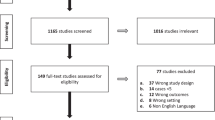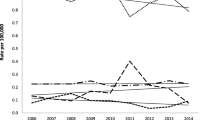Abstract
South Asia and Southeast Asia have a geography that is filled with rivers, resulting in pervasive exposure to water. With a significant proportion of the regional population living in rural areas, the inherent risks of unintentional drowning are constantly elevated. This is further exacerbated by near-annual flooding resulting from heavy monsoon rains that occur across much of South Asia [1–3]. In recent years, natural calamities have further heightened the death toll attributed to drowning, as seen during the 2004 and 2011 tsunamis centered in the Pacific Ocean, unprecedented flooding in Pakistan, and devastating cyclones hitting coastal Bangladesh and India [4–6]. According to the 2004 Global Burden of Disease data, high fatal drowning rates are documented for both South Asian and Southeast Asian countries [7, 8]. Specifically, World Health Organization (WHO) data show that Southeast Asian males drown at rates of 7.3/100,000 population and females at 5.2/100,000 population [9].
Access provided by Autonomous University of Puebla. Download chapter PDF
Similar content being viewed by others
Keywords
These keywords were added by machine and not by the authors. This process is experimental and the keywords may be updated as the learning algorithm improves.
South and Southeast Asia have a geography that is filled with rivers, resulting in pervasive exposure to water. With a significant proportion of the regional population living in rural areas, the inherent risks of unintentional drowning are constantly elevated. This is further exacerbated by near-annual flooding resulting from heavy monsoon rains that occur across much of South Asia [1–3]. In recent years, natural calamities have further heightened the death toll attributed to drowning, as seen during the 2004 and 2011 tsunamis centered in the Pacific Ocean, unprecedented flooding in Pakistan, and devastating cyclones hitting coastal Bangladesh and India [4–6]. According to the 2004 Global Burden of Disease data, high fatal drowning rates are documented for both South Asian and Southeast Asian countries [7, 8]. Specifically, World Health Organization (WHO) data show that Southeast Asian males drown at rates of 7.3/100,000 population and females at 5.2/100,000 population [9].
Globally, among infants to 4-year-olds, drowning was the 13th leading cause of all causes of death for both sexes resulting in more than 58,000 deaths a year. The regional variation from drowning reflects high rates for both South Asian and Southeast Asian countries. In Southeast Asia, drowning is one of the leading causes of death among children ages 15 years and younger [7]. Despite this extensive burden, childhood drowning remains a neglected cause of mortality, gaining little policy or public health attention in the region [8].
The actual number of drowning deaths in South and East Asia is likely to be much higher than the Global Burden of Disease data suggest. Community surveys in five countries within this region indicate that drowning has been greatly underestimated by traditional methods of surveillance. In the countries studied, the death rate for drowning was 30 per 100,000 population in contrast to the rate obtained by the Global Burden of Disease project of 6.6 per 100,000 population for the Southeast Asia region and 13.9 per 100,000 for the Western Pacific Region in which these countries are located [10]. One possible reason for this disparity is that the Global Burden of Disease estimates of death rates from drowning exclude submersions as a result of floods and water transport incidents. This exclusion is likely to lead to a significant underestimate of the death rates in low-income countries experiencing seasonal or periodic flooding [11].
Both China and India, which are the most populous low- and middle-income countries (LMICs) of the world, have high drowning mortality rates and together contribute 49 % of the world’s drowning deaths and about 50 % of the total disability-adjusted life year (DALY) rates attributed to drowning globally. These two nations lead in total numbers of drowning deaths, followed in order by Nigeria, the Russian Federation, Indonesia, and Bangladesh [9]. Unintentional drowning among adults has been documented in South Asia but is often challenging to disentangle from suicidal drowning [12, 13].
Drowning has been studied in a few Asian countries, with evidence suggesting that its greatest impact is on child health. Disability and death from injuries have already taken a leading role in older children (ages 6–14 years) and may be the leading cause of death among 15–18-year-olds. A review of more than 300 pediatric deaths (ages 0–14 years) in the United Arab Emirates revealed that drowning was the second leading cause of death for both genders [14]. Fatal drowning is also the second leading cause of death among 10–19-year-olds in Taiwan and the leading cause for males ages 10–14 years [15]. What is more significant is that there has been no decline in drowning mortality over the past three decades in Taiwan, yet drowning claims the lives of 350 older children annually [15].
Most drowning incidents in LMICs are not associated with recreation or leisure, as is commonly the case in high-income countries, but rather with everyday activities near bodies of water such as rivers, wells, and buckets [12, 13]. Descriptive surveys and epidemiologic studies suggest that persons living in rural areas are at greater risk of drowning than those living in urban areas [16], probably indicating greater exposure to unprotected waters. As in many other regions, males account for a higher proportion of fatal drownings than females, and children ages 1–4 years are at greatest risk [17–19].
Case-control studies of drowning in young children have identified both sociodemographic risk factors and the risk factors associated with proximity to bodies of water. One such study in Bangladesh, a country with a drowning problem massively disproportionate to its small geographic size, shows that the risk of drowning increased with the age of the mother and increased much more sharply with increasing numbers of children in the family [20]. Absence of adult supervision has been noted as a significant factor associated with child drowning in a number of South Asian settings [8, 16]. Unintentional injury is the biggest killer of children ages 1–15 years in Bangladesh, with the greatest mortality risk attributed to drowning. Among Bangladeshi children ages 1–4 years, drowning accounts for 20 % of childhood mortality, causing 46 child deaths each day [21]. A 10-year review of a surveillance system identified 489 fatal drownings among children age of 5 years and younger. These data revealed also that nearly 60 % of these deaths were among children ages 1–2 years, for a very high drowning mortality rate of 521 per 100,000 children [8]. With the world’s highest density of rivers per surface area, 7 % of Bangladesh is covered by water, thus increasing the risk of drowning. Based on population surveillance effort in Matlab, a research site in southern Bangladesh, 75 % of drowning takes place in natural bodies of water less than 20 m from the home. Dominant risk factors for childhood drowning include inadequate supervision, rural residence, male gender, and the monsoon rainy season which is between April and September [13, 22, 23]. Poverty and illiteracy were also found to be significant risk factors for drowning in a typical rural community [8], which are likely rooted in complex cultural beliefs of supernatural causes of drowning and traditional resuscitation practices of unknown benefit [22].
Preventing fatal drowning in these high-risk populations where the burden is the highest presents a multifaceted, complex set of challenges for public health.
References
Biswas A, Rahman A, Mashreky S et al (2010) Unintentional injuries and parental violence against children during flood: a study in rural Bangladesh. Rural Remote Health 10:1199
Dyer O (2007) Waterborne diseases pose threat in Pakistan as floods strike. BMJ 335(7610):66
Siddique AK, Baqui AH, Eusof A et al (1991) 1988 floods in Bangladesh: pattern of illness and causes of death. J Diarrhoeal Dis Res 9:310–314
Solberg K (2010) Worst floods in living memory leave Pakistan in paralysis. Lancet 376(9746):1039–1040
Warraich H, Zaidi AK, Patel K (2011) Floods in Pakistan: a public health crisis. Bull World Health Organ 89:236–237
Roy N (2006) The Asian tsunami: PAHO disaster guidelines in action in India. Prehosp Disaster Med 21:310–315
Ahmed N, Andersson R (2002) Differences in cause-specific patterns of unintentional injury mortality among 15-44-year-olds in income-based country groups. Accid Anal Prev 34:541–551
Borse NN, Hyder AA, Streatfield PK et al (2011) Childhood drowning and traditional rescue measures: case study from Matlab, Bangladesh. Arch Dis Child. doi:10.1136/adc.2010.202010
World Health Organization (2011) Global burden of disease datasets (public domain WHO http://www.who.int/healthinfo/global_burden_disease/estimates_regional/en/index.html). Disease and injury regional estimates, and regional burden of disease estimates for 2004. Calculations by Labrique and Hyder
Linnan M, Anh LV, Cuong PV et al (2007) Child mortality and injury in Asia: survey results and evidence. UNICEF Innocenti Research Centre, Florence
Rahman A, Giashuddin SM, Svanstrom L et al (2006) Drowning – a major but neglected child health problem in rural Bangladesh: implications for low income countries. Int J Inj Contr Saf Promot 13:101–105
Celis A (1997) Home drowning among preschool age Mexican children. Inj Prev 3:252–256
Hyder AA, Arifeen S, Begum N et al (2003) Death from drowning: defining a new challenge for child survival in Bangladesh. Inj Control Saf Promot 10:205–210
Bener A, Al Salman KM, Pugh RN (1998) Injury mortality and morbidity among children in the United Arab Emirates. Eur J Epidemiol 14:175–178
Wang CS, Chou P (1997) An analysis of unnatural deaths between 1990 and 1994 in A-Lein, Taiwan. Injury 28:203–208
Fang Y, Dai L, Jaung MS et al (2007) Child drowning deaths in Xiamen city and suburbs, People’s Republic of China, 2001. Inj Prev 13:339–343
de Francisco A, Hyder AA, Shams EA, Baqui AH (2003) The dangers of childhood. Lancet 361(9351):86
Kozik CA, Suntayakorn S, Vaughn DW et al (1999) Causes of death and unintentional injury among schoolchildren in Thailand. Southeast Asian J Trop Med Public Health 30:129–135
Tan RM (2004) The epidemiology and prevention of drowning in Singapore. Singapore Med 45:324–329
Ahmed MK, Rahman M, van Ginneken J (1999) Epidemiology of child deaths due to drowning in Matlab, Bangladesh. Int J Epidemiol 28:306–311
Hyder AA, Borse NN, Blum L et al (2008) Childhood drowning in low- and middle-income countries: urgent need for intervention trials. J Paediatr Child Health 44:221–227
Blum LS, Khan R, Hyder AA et al (2009) Childhood drowning in Matlab, Bangladesh: an in-depth exploration of community perceptions and practices. Soc Sci Med 68:1720–1727
Iqbal A, Shirin T, Ahmed T et al (2007) Childhood mortality due to drowning in rural Matlab of Bangladesh: magnitude of the problem and proposed solutions. J Health Popul Nutr 25:370–376
Author information
Authors and Affiliations
Corresponding author
Editor information
Editors and Affiliations
Rights and permissions
Copyright information
© 2014 Springer-Verlag Berlin Heidelberg
About this chapter
Cite this chapter
Labrique, A., Hyder, A. (2014). The Burden of Drowning: Issues in Selected Countries – South and Southeast Asia. In: Bierens, J. (eds) Drowning. Springer, Berlin, Heidelberg. https://doi.org/10.1007/978-3-642-04253-9_17
Download citation
DOI: https://doi.org/10.1007/978-3-642-04253-9_17
Published:
Publisher Name: Springer, Berlin, Heidelberg
Print ISBN: 978-3-642-04252-2
Online ISBN: 978-3-642-04253-9
eBook Packages: MedicineMedicine (R0)




